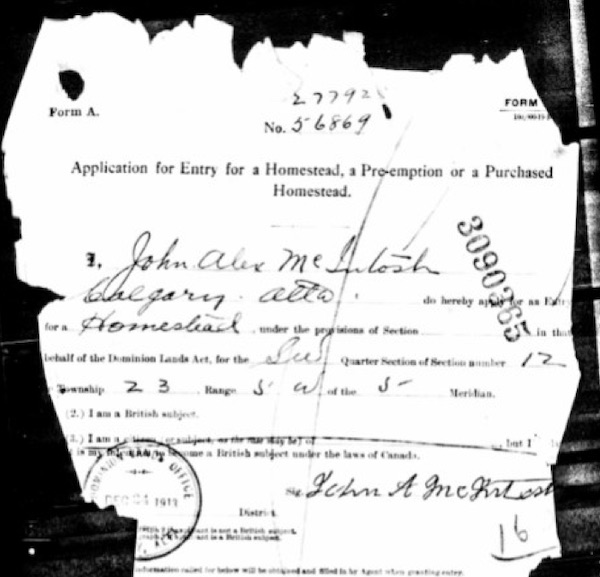The Mysterious Disappearance of John A. McIntosh: Part 1
Local writer Joan Merryfield is sitting at her kitchen table, getting ready to open the mail. There is a letter addressed to her from the Attorney General’s Office, Criminal Justice Section. She opens the letter dated April 26th, 1974:
Dear Mrs. Merryfield, Your letter to the Attorney General’s Department concerning the late and lost Mr. John A. McIntosh came to my desk…
On December 10, 1915, the Calgary Herald’s headline read “Team of Man Who Drove Into Foothills Returns Without Owner”. The day before, a resident of the Holmpatrick subdivision (now Calgary’s community of Glenbrook), noticed neighbour John A. McIntosh’s team of horses standing near his house, harnessed and hooked up to a wagonload of wood. Later, he noticed them again. And they were still there in the late evening. The neighbour investigated and found no trace of McIntosh.
We know that McIntosh originally hailed from Inverness, Scotland, and on December 24, 1913, had registered for land patent SW 1⁄4 12-23-5W5 (now part of the Bragg Creek Provincial Park). He made periodic trips by team and wagon to Bragg Creek to cut firewood, then hauled it back to Calgary. Over two years, he built a cabin and barn near the road that now enters the Provincial Park and always kept an open hole in the river ice to access water for his horses.
But the man old-timers of the area called “old Mac” was rarely seen by or associated with anyone. Circle 5’s Jake Fullerton and daughter Freda passed along the trail by the McIntosh cabin the morning of December 9 and saw him nailing boards over the cabin window, while his team was hitched to the wagon with a load of wood. Jake and McIntosh exchanged a wave and that was the last anyone saw of him.
A day later, a police officer from the city and a Mountie from the R .N.W.M.P.* left Calgary for the foothills, following the trail that McIntosh had likely travelled. They feared they would find McIntosh dead or injured somewhere along the route. People reported having seen McIntosh on his wagon at several points along what was called the road to Calgary (Highway 8). The most reliable report was from the Rippon family, who passed McIntosh and wagon on their way to Calgary as he was leaving the northern border of the Tsuut’ina land. The Rippons rested at Robinson’s (a familiar half-way stop) and then should have caught up to him along the road, but they never saw the team or man again. The local Ford brothers claimed they had met him somewhere along the road and another report had him driving his team near the Twin Bridges area. One party said they had seen the team travelling toward Calgary without a driver. But still no McIntosh.
Wait a minute… even by 1915 standards, the trail to Calgary was well-travelled and the countryside was far from the wild west. McIntosh was travelling by team and if, as the police feared, he had an accident, his body should have been found on or near the trail. He could have fallen into the Elbow River, but again wouldn’t the body be found somewhere downstream? And the team made it back to Calgary, with wagon and wood intact. Something doesn’t add up. Watch for Part 2 of this story in the next edition of the High Country News.
Submitted by Michele McDonald
*Royal North West Mounted Police
Sources: Homestead Records, 1870-1030, Acc.1970.313 – Film 2443 – File 3090365, Ancestry. ca., (via Alberta Genealogical Society); Purmal, Freda l, “The Mysterious Disappearance of John A. McIntosh”, Our Foothills, pg. 420; “Fear John M’Intosh Has Had Accident”, Calgary Herald, Pg. 1, December 10, 1915; J.E. Mos correspondence to Joan Merryfield, Alberta Attorney General, Criminal Justice Section Crown Counsel, April 26, 1974.


























